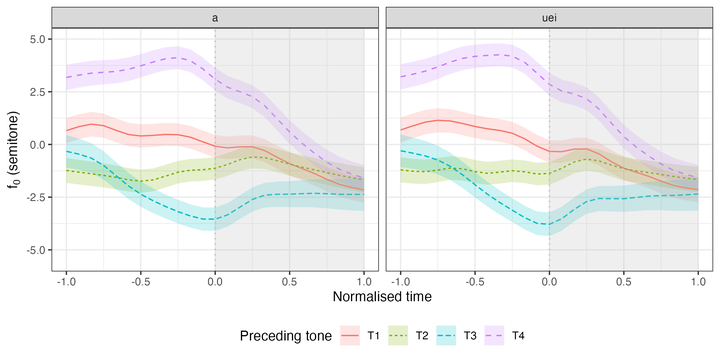 Fitted f0 contours of eight Plastic Mandarin [X-de] phrases (duration: 250 ms), grouped by the vowel and tone category of the preceding syllable of de. The colourful shades indicate 95% pointwise confidence intervals. The dotted line at 0.0 indicates syllable boundary. The normalised time domain [-1, 0] shows f0 contours of the lexical tone syllable X and [0, 1] the neutral tone syllable de (in grey background).
Fitted f0 contours of eight Plastic Mandarin [X-de] phrases (duration: 250 ms), grouped by the vowel and tone category of the preceding syllable of de. The colourful shades indicate 95% pointwise confidence intervals. The dotted line at 0.0 indicates syllable boundary. The normalised time domain [-1, 0] shows f0 contours of the lexical tone syllable X and [0, 1] the neutral tone syllable de (in grey background).Abstract
With an aim to investigate the nature of Mandarin neutral tone through the lens of language variation and change, this study examines the pitch patterns of speech sequences containing neutral tone syllables, i.e. those that do not have any of the four canonical lexical tones and are often overlooked in prior studies of tones, in two Mandarin varieties: Standard Mandarin and Plastic Mandarin spoken in Changsha, China. Using Generalised Additive Mixed Models, the study shows (a) that f0 contours of a sequence of neutral tone syllables following various lexical tones converge in the end at a low pitch in both Mandarin varieties, and (b) that the low pitch target of neutral tone syllables tends to be the same across the two Mandarin varieties. The cross-dialectal comparison favours the phonological account that neutral tone is underlyingly underspecified and attracts the boundary tone. It suggests that the constant pitch target across two Mandarin varieties with distinct lexical tone contours may be attributed to the stable transfer of prosodic structure in the Standard-Plastic variation.
Highlights:
A neutral tone tends to approach a low pitch target in Plastic Mandarin.
Same low pitch target of neutral tone across two Mandarin varieties.
Mandarin neutral tone may be underspecified and attract the boundary tone.
Stable transfer of prosodic structure in the Standard-Plastic Mandarin variation.